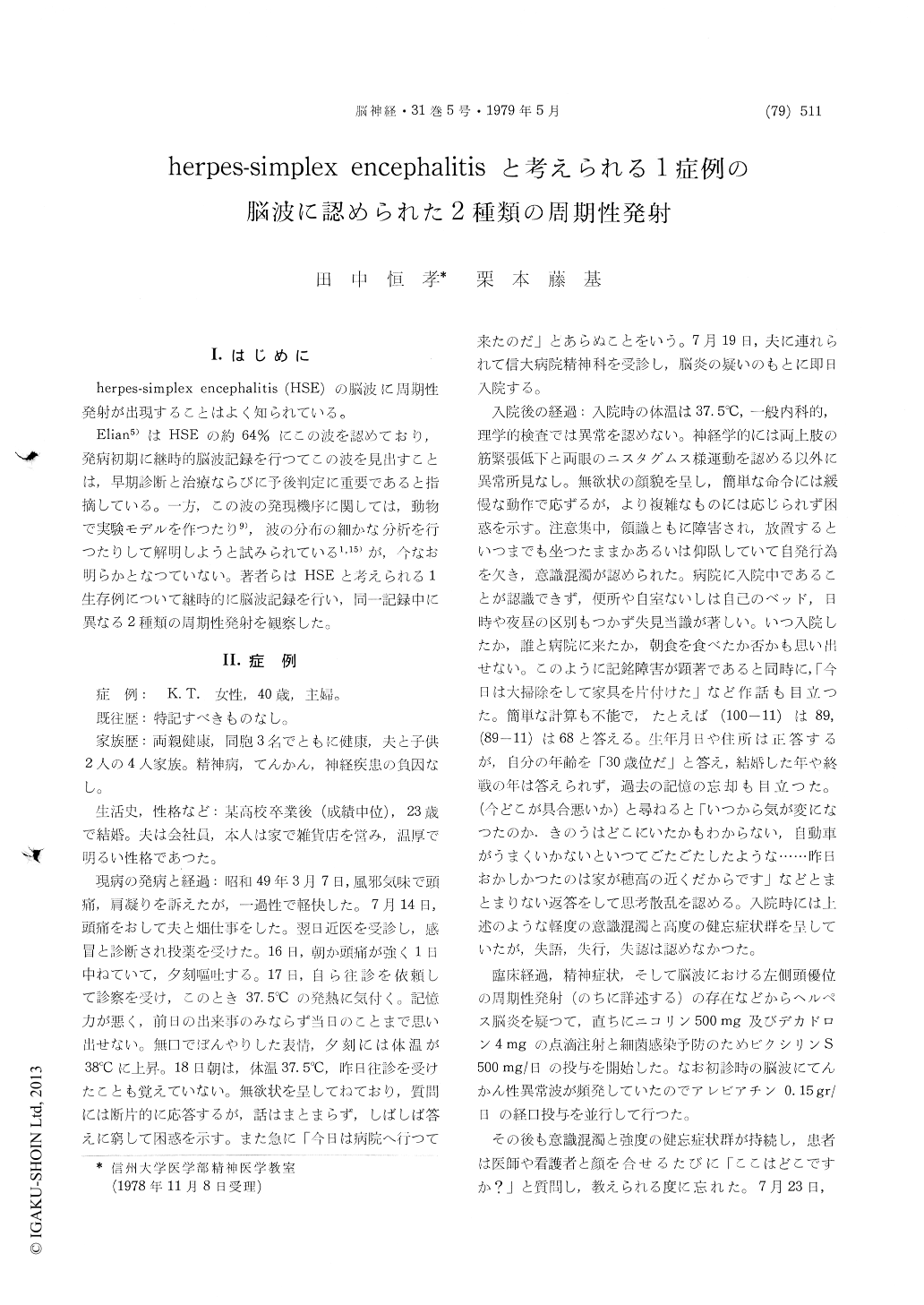Japanese
English
- 有料閲覧
- Abstract 文献概要
- 1ページ目 Look Inside
I.はじめに
herpes-simplex encephalitis (HSE)の脳波に周期性発射が出現することはよく知られている。
Elian5)はHSEの約64%にこの波を認めており,発病初期に継時的脳波記録を行つてこの波を見出すことは,早期診断と治療ならびに予後判定に重要であると指摘している。一方,この波の発現機序に関しては,動物で実験モデルを作つたり9),波の分布の細かな分析を行つたりして解明しようと試みられている1,15)が,今なお明らかとなつていない。著者らはHSEと考えられる1生存例について継時的に脳波記録を行い,同一記録中に異なる2種類の周期性発射を観察した。
The EEG findings of a 40-year-old woman with a suspicion of herpes-simplex encephalitis (HSE) were reported. This patient was admitted to Shinshu University Hospital on the six day after the onset of her present illness, when she was slightly clouded and highly amnestic. EEG findings were as follows :
1) An EEG on the day of admission showed a remarkably slow background activity and periodic discharges, consisting of a high-amplitude delta wave, which predominated in the left temporal area and repeated at regular intervals of 2-2.5 seconds. During the same recording, bisynchronous high-amplitude slow wave bursts and spike-wave complexes occurred frequently, and they often were followed by periodic lateralized epileptiform discharges (PLEDs) in the left temporal region, which recurred in a quasi-rhythmic fashion at a frequency of every 1-1.5 seconds and lasted for 20-30 seconds. The above-mentioned periodic dis-charges (PDs) vanished during PLEDs and other epileptic discharges, and reappeared after the ter-mination of these seizure discharges. No convulsion occurred clinically. Hereafter, anticonvulsants were administered to the patient.
2) On the fourth day of admission her conscious-ness was considerably clouded and often delirious. In this time an EEG showed a remarkably slow background activity and PDs. The latter consisted of high-voltage triphasic waves which recurred atless regular intervals of 0.5-1.5 seconds. The PDs appeared bisynchronously, but these predominated at the right side in temporal regions. There was no occurrence of PLED and other epileptic dis-charges. In the contrast with the EEG on the day of admission, it was noteworthy that the laterality of PDs had shifted from the left to the right side in temporal regions.
3) On the tenth day of admission the patient's consciousness was clear, while she revealed amnestic syndrome. An EEG recorded at this time showed a slow alpha pattern intermixed with 5-6 Hz theta waves. Repetitive delta waves, focal in the right temporal area, at intervals of 1-1.5 seconds, were seen only during drowsiness.
4) Thereafter, with the improvement of her illness EEGs also normalized gradually.
On the basis of the above-mentioned observations, it is concluded that the PDs characteristic of HSE essentially differ from the PLEDs which were described by Chatrian et al.

Copyright © 1979, Igaku-Shoin Ltd. All rights reserved.


